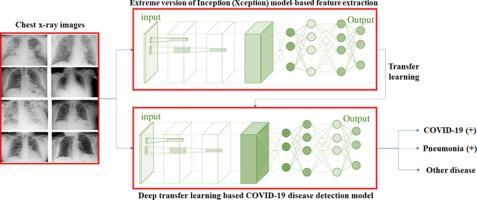IRBM ( IF 5.6 ) Pub Date : 2020-07-03 , DOI: 10.1016/j.irbm.2020.07.001 N Narayan Das 1 , N Kumar 2 , M Kaur 3 , V Kumar 4 , D Singh 5

|
The most widely used novel coronavirus (COVID-19) detection technique is a real-time polymerase chain reaction (RT-PCR). However, RT-PCR kits are costly and take 6-9 hours to confirm infection in the patient. Due to less sensitivity of RT-PCR, it provides high false-negative results. To resolve this problem, radiological imaging techniques such as chest X-rays and computed tomography (CT) are used to detect and diagnose COVID-19. In this paper, chest X-rays is preferred over CT scan. The reason behind this is that X-rays machines are available in most of the hospitals. X-rays machines are cheaper than the CT scan machine. Besides this, X-rays has low ionizing radiations than CT scan. COVID-19 reveals some radiological signatures that can be easily detected through chest X-rays. For this, radiologists are required to analyze these signatures. However, it is a time-consuming and error-prone task. Hence, there is a need to automate the analysis of chest X-rays. The automatic analysis of chest X-rays can be done through deep learning-based approaches, which may accelerate the analysis time. These approaches can train the weights of networks on large datasets as well as fine-tuning the weights of pre-trained networks on small datasets. However, these approaches applied to chest X-rays are very limited. Hence, the main objective of this paper is to develop an automated deep transfer learning-based approach for detection of COVID-19 infection in chest X-rays by using the extreme version of the Inception (Xception) model. Extensive comparative analyses show that the proposed model performs significantly better as compared to the existing models.
中文翻译:

基于自动化深度迁移学习的方法用于检测胸部 X 光中的 COVID-19 感染
最广泛使用的新型冠状病毒(COVID-19)检测技术是实时聚合酶链反应(RT-PCR)。然而,RT-PCR 试剂盒价格昂贵,并且需要 6-9 小时才能确认患者感染。由于 RT-PCR 的敏感性较低,其假阴性结果较高。为了解决这个问题,使用胸部 X 光和计算机断层扫描 (CT) 等放射成像技术来检测和诊断 COVID-19。在本文中,胸部 X 光检查优于 CT 扫描。其背后的原因是大多数医院都配备了X光机。 X 光机比 CT 扫描机便宜。除此之外,X 射线的电离辐射比 CT 扫描低。 COVID-19 揭示了一些可以通过胸部 X 光检查轻松检测到的放射特征。为此,放射科医生需要分析这些特征。然而,这是一项耗时且容易出错的任务。因此,需要自动化胸部 X 射线分析。胸部X光片的自动分析可以通过基于深度学习的方法来完成,这可能会加快分析时间。这些方法可以在大型数据集上训练网络的权重,也可以在小型数据集上微调预训练网络的权重。然而,这些应用于胸部 X 光检查的方法非常有限。因此,本文的主要目标是开发一种基于自动化深度迁移学习的方法,通过使用 Inception (Xception) 模型的极端版本来检测胸部 X 射线中的 COVID-19 感染。广泛的比较分析表明,与现有模型相比,所提出的模型的性能明显更好。











































 京公网安备 11010802027423号
京公网安备 11010802027423号